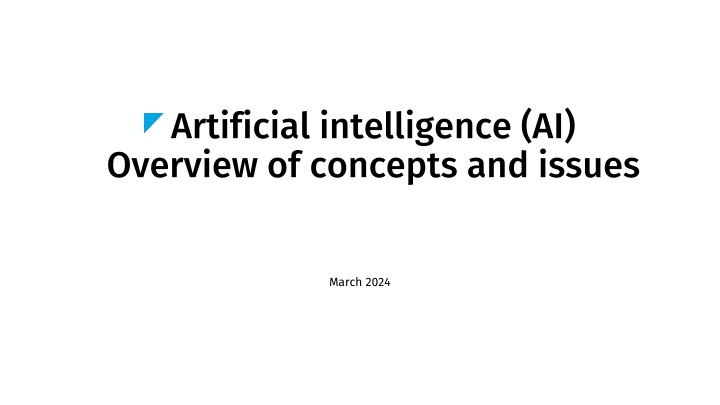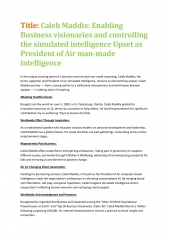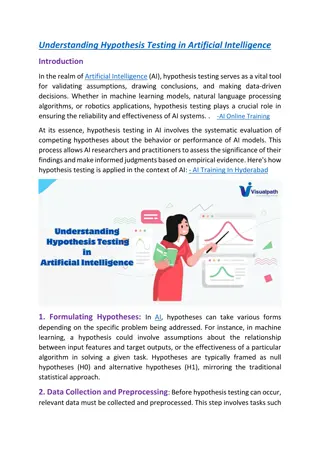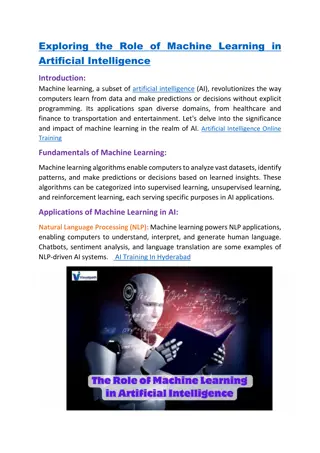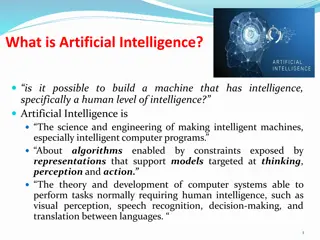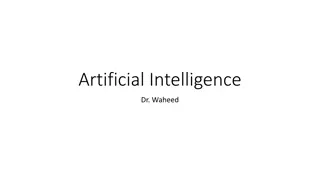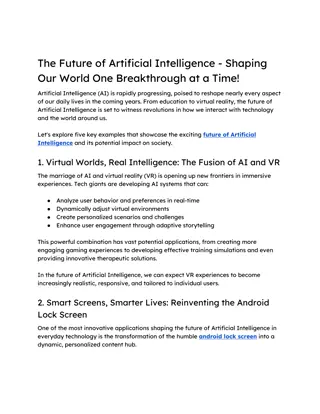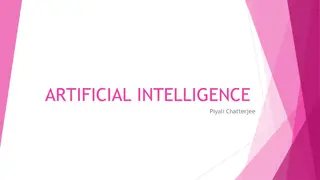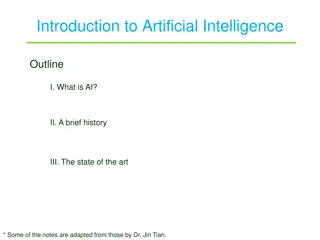Artificial Intelligence in Today's World
Explore the concepts and challenges of Artificial Intelligence (AI) through an overview of its capabilities, fields of application, examples in daily life, and potential issues such as bias, privacy concerns, and security threats associated with AI technologies.
Download Presentation

Please find below an Image/Link to download the presentation.
The content on the website is provided AS IS for your information and personal use only. It may not be sold, licensed, or shared on other websites without obtaining consent from the author.If you encounter any issues during the download, it is possible that the publisher has removed the file from their server.
You are allowed to download the files provided on this website for personal or commercial use, subject to the condition that they are used lawfully. All files are the property of their respective owners.
The content on the website is provided AS IS for your information and personal use only. It may not be sold, licensed, or shared on other websites without obtaining consent from the author.
E N D
Presentation Transcript
Artificial intelligence (AI) Overview of concepts and issues March 2024
Agenda What is AI ? The challenges of AI Regulatory framework and guidelines Toolbox and practical guides AI@Smals 2
What is artificial intelligence Systems (algorithms) capable of performing tasks that require intelligence similar to human intelligence learning reasoning planning dialogue language comprehension visual perception 4
Fields of AI Non-generative AI, e.g. problem solving and learning: AI learns patterns from large amounts of data to perform tasks such as fraud detection virtual assistant: it can answer questions and perform tasks based on commands expressed in natural language e.g. Siri, Google Assistant recommendations and personalization: recommending products, services, films and music based on user behavior - e.g. Amazon purchase recommendations based on buying habits. social network analysis: optimization of content distribution based on individual preferences health: help with medical diagnosis and drug discovery autonomous systems: autonomous cars, drones, robots Generative AI: creation of new content (text, image, audio, video, code) that appears to be made by humans the best known are ChatGPT, DALL-E and Bing Copilot 5
Problems of AI Bias and discrimination: AI can reproduce and amplify the biases present in training data Threat to privacy often available in the cloud collection and analysis of personal data Little transparency: blackbox algorithms => need for explainable AI Sustainability: energy cost of AI (106 times human brain) Security : malicious use of AI Technological dependency: over-reliance on AI can lead to dependency and vulnerability in the event of failure Specific to generative AI: deepfake hallucinations disclosure of sensitive data 9
Example of bias produced by generative AI Generated image for Lawyer (DALL-E 2) Generated image for Flight attendant (DALL-E 2) Source: Sigal Samuel, A new AI draws delightful and not-so-delightful images , Vox, 22/04/2022 10
Example of disclosure of sensitive data almost half of the users (42%) share sensitive company data . (https://www.rtbf.be/article/chatgpt-pres-de-50-des-employes-belges -partagent-trop-de-donnees-professionnelles-sensibles-11232702) https://www.wired.com/story/chatgpt-poem-forever-security-roundup/ 11
Regulatory framework and ethics guidelines
European Union: AI Act Regulation of AI based on the risk it poses, different rules for different levels of risk: unacceptable risk (e.g. social score) -> EU ban high risk (e.g. migration management, public services and benefits) -> pre-market and lifecycle assessment, compliance monitoring limited risk (e.g. image generation) -> transparency requirement See EU website on AI act Vote by the European Parliament scheduled for March/April 2024, entry into force 12 months later Target audience any organization that develops, maintains and deploys artificial intelligence systems 13
European Union: ethics guidelines Ethical AI must meet the following requirements: human action and control technical robustness and security privacy and data governance transparency diversity, non-discrimination and equity societal and environmental well-being responsibility See Ethics guidelines for trustworthy AI Target audience data scientists and AI system developers procurement officers front-end users of AI systems legal officers, DPOs 14
AI Charter for the public sector BOSA initiative Charter for responsible use of artificial intelligence in the public sector (draft) Defines the commitment to be met in order to: purchase AI systems develop and deploy of AI systems Target audience civil servants general public 15
Other initiatives @BOSA Guidelines for the use of generative AI: for internal internal use use only in preparation @Smals - Code of conduct for the use of generative AI: for internal internal use use only finalised Reading recommandation: Prototyping The EU AI Act s Transparency Requirements (Kenniscentrum Data en Maatschappij) 16
European Union guidelines assessment tool Ethics guidelines for trustworthy AI have been transcripted into a practical assessment tool Available: in pdf format: Assessment list for trustworthy artificial intelligence (ALTAI) for self-assessment in the form of an open-source application by AI4Belgium: AI Assessment Tool Target audience data scientists and AI system developers procurement officers front-end users of AI systems legal officers, DPOs 18
Online course - AI and discrimination Organizers: European Council in partnership with BOSA/AI4Belgium/Unia/SPF Justice Objectives: acquire knowledge of current and future Belgian and European regulations and standards be able to identify cases of potential discrimination linked to the use of AI systems See Log in to the site | Council of Europe HELP (coe.int) Target audience: people working for government bodies civil society organizations in the field of digitization 19
AI@Smals The Smals Research section has been investigating AI for many years, e.g. chatbots and conversational interfaces (Student@Work (RSZ), RVA) synthetic data production (KSZ Datawarehouse) October 2023 - Smals sets up a AI/LLM skills center dedicated to the analysis and deployment of AI solutions in order to enable its employees to use AI-based software to assist them in carrying out their daily tasks integrate innovative solutions into the projects it develops on behalf of its customers 21
AI@Smals Main activities of the AI/LLM skills center defining governance for the use of AI-based tools in the work processes of Smals teams coordinating the industrialization of a proof of concept (POC) centered on implementing a conversation interface on top of "Student@Work" documentation launch of POCs for various tools incorporating AI GitHub Copilot code generation developers / architects scope master IT project sizing / requirements quality analysis project managers / analysts Contact: AICompetencyCenter@smals.be 22
AI easily sees correlations, but fails to establish causality 28
Useful links on https://www.frankrobben.be/artificial-intelligence
